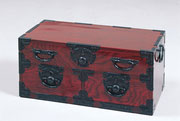Aomori and more
- Sort by
- Popularity
- Name
-
Mashiko ware Mashiko yaki
- Ceramic
- Tochigi

Mashiko ware (called Mashiko yaki in Japanese) is produced in the area around the town of Mashiko in Tochigi prefecture. The clay used in Mashiko ware is rich in silicic acid and iron with a high plasticity, making it easy to shape and highly fire…
View more
-
Kumano brushes Kumano fude
- Writing tools
- Hiroshima

Kumano brushes (called Kumano fude in Japanese) are traditional craftworks produced in the city of Kumano in Hiroshima prefecture, hence the name. They are made from a wide variety of hair including goat, horse, deer, Japanese raccoon dog, weasel,…
View more
-
Tsugaru lacquerware Tsugaru nuri
- Lacquerware
- Aomori

Tsugaru lacquerware (called tsugaru nuri in Japanese) is produced around the city of Hirosaki in Aomori prefecture. Lacquerware has been produced in this region since the middle of the Edo period (1603-1868), but it began to be called Tsugaru lacq…
View more
-
Ogatsu inkstone Ogatsu suzuri
- Writing tools
- Miyagi

Ogatsu inkstone (called Ogatsu suzuri in Japanese) is a craft produced in the former town of Ogatsu (now city of Ishinomaki), Miyagi prefecture, where artisans still carefully hand carve and polish every piece. What is unique to Ogatsu inkstone i…
View more
-
Shodai ware Shodai yaki
- Ceramic
- Kumamoto

Shodai ware (called Shodai yaki in Japanese) is a form of pottery baked mainly in the northern part of Kumamoto prefecture. This craft is distinguishable because of its simple texture, strong form, and bold design, which is due to the pouring meth…
View more
-
Yamaga lanterns Yamaga toro
- Other crafts
- Kumamoto

Yamaga toro are lanterns made of washi (traditional Japanese paper) produced in the area surrounding the city of Yamaga, Kumamoto prefecture. For the Yamaga Lantern Festival, an annual summer event, this craft is worn by one thousand dancing women…
View more
-
Nara brushes Nara fude
- Writing tools
- Nara

Nara brushes (called Nara fude in Japanese) are brushes produced in and around the neighboring cities of Nara and Yamatokoriyama, Nara prefecture. Nara is considered to be the birthplace of brush making in Japan. The oldest existing brushes in Jap…
View more
-
Naruko lacquerware Naruko shikki
- Lacquerware
- Miyagi

Naruko lacquerware (called Naruko shikki in Japanese) is a form of lacquerware produced around the city of Osaki, Miyagi prefecture. Lacquerware is a craft coating layers of lacquer on wooden tableware and other utensils. Lacquerware is produced i…
View more
-
Amakusa ceramics Amakusa tojiki
- Ceramic
- Kumamoto

Amakusa ware (called Amakusa Tojiki in Japanese) is a form of pottery or porcelain baked in the Amakusa region of Kumamoto prefecture. The name was newly applied when the craft was designated as a national traditional craft. In Amakusa, where high…
View more
-
Miyagi kokeshi doll Miyagi dento kokeshi
- Dolls, kokeshi
- Miyagi

Miyagi Kokeshi Dolls (called Miyagi Dento Kokeshi in Japanese) are wooden dolls produced in and around the cities of Sendai and Shiraishi, Miyagi prefecture. Categorized based on region into five styles including Naruko kokeshi and Togatta kokeshi…
View more
-
Fukuyama Koto (Japanese Harp) Fukuyama koto
- Other crafts
- Hiroshima

Fukuyama koto is a Japanese harp, koto, produced in Fukuyama, Hiroshima prefecture. Most of the koto produced in Japan are made in Fukuyama, which is where the coastal view of the city inspired one of the most well-known koto songs, Haru no Umi (S…
View more
-
Miyajima woodwork Miyajima zaiku
- Wood, bamboo crafts
- Hiroshima

Miyajima Woodwork (called Miyajima zaiku in Japanese) are woodwork products made in Miyajima, Hatsukaichi, Hiroshima prefecture. Miyajima Island, one of the Three Views of Japan*, has long been nicknamed the "Island of Gods", while Hatsu…
View more
-
Hiroshima Buddhist altar Hiroshima butsudan
- Household Buddhist altars
- Hiroshima

Hiroshima Butsudan are golden Buddhist altars mainly produced in Hiroshima City, Hiroshima Prefecture. The Buddhist sect, Jodo Shinshu has been widely worshipped in Hiroshima since ancient times, and many golden altars recommended by the sect were…
View more
-
Kawajiri brushes Kawajiri fude
- Writing tools
- Hiroshima

Kawajiri Brushes, called Kawajiri Fude in Japanese are mainly used for calligraphy and they are produced in the town of Kawajiri in the east of the city of Kure, Hiroshima prefecture. This town, lying at the foot of Mt. Noro and fronting onto the …
View more
-
Higo inlays Higo zogan
- Metal works
- Kumamoto

Higo Zogan is inlaid metal work produced in Kumamoto, Kumamoto prefecture. This craft was formerly used to adorn the gun barrels or sword guards of samurai. Today, however, the skills are used to make personal accessories or interior ornaments. Th…
View more
-
Takayama tea whisks Takayama chasen
- Wood, bamboo crafts
- Nara

Takayama Tea Whisks, called Takayama Chasen in Japanese, are tea whisks produced in Takayama Town, Ikoma City, Nara Prefecture. Each tea whisk is completely made by hand and they have a top class share in the total Japanese tea whisk market. The t…
View more
-
Nara Ink Nara sumi
- Writing tools
- Nara

Nara Ink, called Nara Sumi in Japanese, is Japanese ink (sumi) produced in Nara, Nara prefecture. It was the second sumi, following Suzuka Sumi of Mie prefecture, to be designated as a traditional craft. There are two types of sumi; shoenboku, mad…
View more
-
Sendai traditional chest Sendai tansu
- Wood, bamboo crafts
- Miyagi

Sendai tansu is a type of chest of drawers made in the city of Sendai, Miyagi prefecture. Usually they are made of Japanese chestnut, cedar, and zelkova wood, and renowned for their highly ornamented iron fittings and three different types of beau…
View more
- 1

































































































































































































































































































